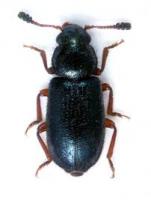Adult
Size
3.5 to 7 mm long
Aspect
Elongate body, elytra 2.5-fold more in length than in width.
Rather short, 11-articled antennae, ending in a strong club composed of 3 articles.
Elytra punctuated with 10 longitudinal rows of dark spots and covered in stiff dark bristles also visible on the sides of the thorax.
Colour
Metallic blue glint on the whole body (upper and lower parts, but slightly darker on the lower part), turning purplish or greenish in some cases.
Orange-coloured legs, blackish antennal club.


 Nécrobie à pattes rouges
Nécrobie à pattes rouges  Copra beetle copra red-legged ham beetle
Copra beetle copra red-legged ham beetle  Gorgojo de la copra Escabaro del tocino
Gorgojo de la copra Escabaro del tocino  Schinkenkäfer Koprakäfer Rotbeiniger
Schinkenkäfer Koprakäfer Rotbeiniger 

